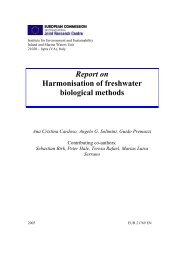Lakes and Watercourses
Lakes and Watercourses
Lakes and Watercourses
You also want an ePaper? Increase the reach of your titles
YUMPU automatically turns print PDFs into web optimized ePapers that Google loves.
TABLE 34.<br />
Reference values for planktonic algae in various lake types<br />
Indicator Lowl<strong>and</strong> lake, Lowl<strong>and</strong> lake, Forest Mountain<br />
shallow* deep* lake* lake*<br />
Total volume, seasonal average, mm 3 /l 1 0.5 0.5 0.5<br />
Total volume, August, mm 3 /l 1.5 0.75 0.5 0.5<br />
Diatom biomass in April/May, mm 3 /l 1 1 0.5 **<br />
Water-blooming cyanobacteria in August, mm 3 /l 0.5 0.5 0.05 **<br />
No. of potentially toxin-producing 4 4 3 2<br />
cyanobacteria (genera) in August<br />
Gonyostomum semen, biomass in August, mm 3 /l 0.1 0.1 0.1 **<br />
* Mountain lake: situated above the tree line<br />
Forest lake: usually, but not always, situated above the reference elevation, referred to in Sweden<br />
as ”the highest coastline”, where surrounding l<strong>and</strong> comprises > 60% forest<br />
Lowl<strong>and</strong> lake: situated on mud sediments, usually below the highest coastline, where surrounding<br />
l<strong>and</strong> comprises > 60% cultivated l<strong>and</strong> (arable l<strong>and</strong>, meadow, fallow, other grazing l<strong>and</strong>).<br />
** No reference values available or the parameter is not relevant to the lake type.<br />
Comments<br />
Classification must be based on samples taken <strong>and</strong> analysed in accordance<br />
with the Swedish EPA Environmental Monitoring H<strong>and</strong>book.<br />
Assessment need not necessarily be made using all parameters for a given<br />
lake. The choice of parameters is governed by the aspects of the presence<br />
of planktonic algae to be highlighted <strong>and</strong> the availability of background<br />
data. Hence, in some cases assessment will be confined to harmful algae.<br />
In others, assessment may focus on biomass quantities in parallel with the<br />
presence of toxic algae.<br />
In oligotrophic lakes, where there is often little difference from one<br />
year to another, results from a single year may be used for assessment. In<br />
moderately eutrophic <strong>and</strong> eutrophic lakes, on the other h<strong>and</strong>, data<br />
should comprise figures from three years of study, so as to obtain mean<br />
values. Variations between years due to weather have a particularly<br />
marked impact on species balance <strong>and</strong> quantities of various algal groups<br />
in such lakes, which in turn affects total biomass. If an assessment is made<br />
using more limited data, this should be stated.<br />
The scales for the respective parameters, as with the choice of parameters<br />
<strong>and</strong> reference values, are intended to be used during a trial period.<br />
57















![Accommodation booking form [PDF]](https://img.yumpu.com/39471785/1/184x260/accommodation-booking-form-pdf.jpg?quality=85)

